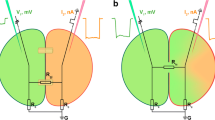Abstract
Gap junctions are considered to serve a similar function in all multicellular animals (Metazoa). Two unrelated protein families are involved in this function: connexins, which are found only in chordates, and pannexins, which are present in the genomes of both chordates and invertebrates. Recent sequence data from different organisms show important exceptions to this simplified scheme. It looks as if Chordate lancelet has only pannexins and no connexins in its genome. New data indicate that some metazoans have neither connexins nor pannexins and use other unidentified proteins to form gap junctions.
Similar content being viewed by others
References
L. M. Chailakhyan, Differentiation 45, 1 (1990).
Y. Panchin, I. Kelmanson, M. Matz, et al., Curr Biol. 10, 473 (2000).
Y. V. Panchin, J. Exp. Biol. 208, 1415 (2005).
O. Litvin, A. Tiunova, Y. Connell-Alberts, et al., J. Cell Mol. Med. 10, 613 (2006).
V. I. Shestopalov and Y. Panchin, Cell Mol. Life Sci. 65(3), 376 (2008).
R. Bruzzone, T. W. White, and D. A. Goodenough, Bioessays 18, 709 (1996).
D. A. Goodenough and D. L. Paul, Nat. Rev. Mol. Cell Biol. 4(4), 285 (2003).
G. Dahl and S. Locovei, IUBMB Life 58(7), 409 (2006).
P. Pelegrin and A. Surprenant, EMBO J. 25, 5071 (2006).
R. J. Thompson, N. Zhou, and B. A. MacVicar, Science 312, 924 (2006).
R. Bruzzone, S. G. Hormuzdi, M. T. Barbe, et al., Proc. Natl. Acad. Sci. USA 100, 13644 (2003).
C. P. Lai, J. F. Bechberger, R. J. Thompson, et al., Cancer Res. 67, 1545 (2007).
R. Dermietzel, T. K. Hwang, and D. S. Spray, Anat. Embryol. (Berl). 182, 517 (1990).
E. J. Furshpan and D. D. Potter, J. Physiol. 145(2), 289 (1959).
M. Levin, J. Membr. Biol. 185(3), 177 (2002).
W. R. Loewenstein, Physiol. Rev. 61, 829 (1981).
P. Phelan and T. A. Starich, Bioessays 23, 388 (2001).
D. L. Caspar, D. A. Goodenough, L. Makowski, and W. C. Phillips, J. Cell Biol. 74, 605 (1977).
L. Makowski, D. L. Caspar, W. C. Phillips, and D. A. Good-enough, J. Cell Biol. 74, 629 (1977).
S. Maeda, S. Nakagawa, M. Suga, et al., Nature 458, 597 (2009).
D. L. Paul, J. Cell Biol. 103, 123 (1986).
K. Willecke, J. Eiberger, J. Degen, et al., Biol. Chem. 383, 725 (2002).
M. Yeager and B. J. Nicholson, Curr. Opin. Struct. Biol. 6(2), 183 (1996).
G. Dahl, T. Miller, D. Paul, et al., Science 236, 1290 (1987).
K. I. Swenson, J. R. Jordan, E. C. Beyer, and D. L. Paul, Cell 57, 145 (1989).
R. Werner, E. Levine, C. Rabadan-Diehl, and G. Dahl, Proc. Natl. Acad. Sci. USA 86, 5380 (1989).
Y. Sasakura, E. Shoguchi, N. Takatori, et al., Dev. Genes. Evol. 213, 303 (2003).
T. W. White and D. L. Paul, Annu. Rev. Physiol. 61, 283 (1999).
D. A. Goodenough, J. Cell Biol. 61, 557 (1974).
T. M. Barnes, Trends Genet. 10(9), 303 (1994).
P. Phelan, L. A. Stebbings, R. A. Baines, et al., Trends Genet. 14(9), 348 (1998).
A. Baranova, D. Ivanov, N. Petrash, et al., Genomics 83, 706 (2004).
Y. V. Panchin and I. V. Kelmanson, Neuroscience 96, 597 (2000).
F. Vanden Abeele, G. Bidaux, D. Gordienko, J. Cell Biol. 174, 535 (2006).
R. Bruzzone, M. T. Barbe, N. J. Jakob, and H. Monyer, J. Neurochem, 92, 1033 (2005).
L. Bao, S. Locovei, and G. Dahl, FEBS Lett. 572, 65 (2004).
S. Locovei, J. Wang, and G. Dahl, FEBS Lett. 580, 239 (2006).
E. Scemes, R. Dermietzel, D. C. Spray, Glia 24(1), 65 (1998).
S. Locovei, L. Bao, and G. Dahl, Proc. Natl. Acad. Sci. USA 103, 7655 (2006).
M. A. Peters, T. Teramoto, J. Q. White, et al., Curr. Biol. 17, 1601 (2007).
Z. F. Altun, B. Chen, Z. Wang, and D. H. Hall, Dev. Dyn. 238, 1936 (2009).
L. Timmons and A. Fire, Nature 395, 854 (1998).
A. M. Jose, J. J. Smith, and C. P. Hunter, Proc. Natl. Acad. Sci. USA 106, 2283 (2009).
W. M. Winston, C. Molodowitch, and C. P. Hunter, Science 295, 2456 (2002).
V. Valiunas, Y. Y. Polosina, H. Miller, et al., J. Physiol. 568, 459 (2005).
E. J. Wolvetang, M. F. Pera, K. S. Zuckerman, Biochem. Biophys. Res. Commun. 363, 610 (2007).
A. Y. Panchin, S. A. Spirin, S. A. Lukyanov, et al., J. Bioinform. Comput. Biol. 6, 759 (2008).
Author information
Authors and Affiliations
Corresponding author
Additional information
Original Russian Text © Yu. V. Panchin, 2011, published in Biofizika, 2011, Vol. 56, No. 3, pp. 481–488.
Rights and permissions
About this article
Cite this article
Panchin, Y.V. Intercellular channels in animals. BIOPHYSICS 56, 457–463 (2011). https://doi.org/10.1134/S0006350911030225
Received:
Published:
Issue Date:
DOI: https://doi.org/10.1134/S0006350911030225




